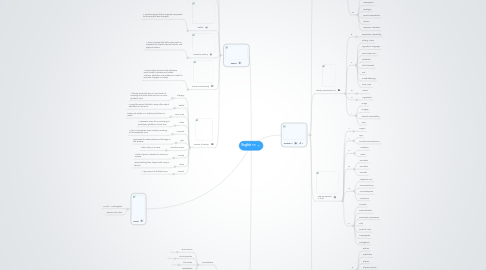
1. Poetry
1.1. Free Verse
1.1.1. A poem that has no end rhyme, regular rhythm, or regulated stanza and line length.
1.2. Lyric
1.2.1. A song-like form of a poem that expresses deep, personal feelings of a speaker or poet.
1.3. Ballad
1.3.1. A narrative poem that is originally composed to be sung but later changed.
1.4. Narrative Poetry
1.4.1. A form of poetry that tells a story with an emphasis on its plot, external events, and physical actions.
1.5. Social Commentary
1.5.1. A serious type of poem that addresses social issues, criticize social habits, customs, attitudes, and problems in order to promote changes in society.
1.6. Genres of Poetry:
1.6.1. Allegory
1.6.1.1. A literary work with two or more levels of meaning-one literal level and one or more symbolic level.
1.6.2. Ballad
1.6.2.1. A song like poem that tells a story often about adventure or romance.
1.6.3. Free Verse
1.6.3.1. Poetry not written in a rhythmical pattern or meter.
1.6.4. Haiku
1.6.4.1. A Japanese verse form consisting of seventeen syllables in three lines.
1.6.5. Limerick
1.6.5.1. A form of nonsense verse usually consisting of five anapestic lines.
1.6.6. Lyric
1.6.6.1. Expresses the observations and feelings of the speaker.
1.6.7. Narrative Poem
1.6.7.1. Tells a story in a verse.
1.6.8. Parody
1.6.8.1. A kind of poem intended to ridicule or criticize.
1.6.9. Satire
1.6.9.1. Verses treating their subject with irony or ridicule.
1.6.10. Sonnet
1.6.10.1. A lyric poem of fourteen lines.
2. Grammar
2.1. Punctuations
2.1.1. The Comma
2.1.1.1. ,
2.1.2. The Semicolon
2.1.2.1. ;
2.1.3. The Colon
2.1.3.1. :
2.1.4. Apostrophe
2.1.4.1. '
2.1.5. Dash
2.1.5.1. -
2.2. Sentences
2.2.1. Made up of 2 sections the the subject and the predicate.
2.3. Clauses
2.3.1. Independent clauses act as complete sentences, while subordinate clauses cannot stand alone and need another clause to complete their meaning.
2.4. Phrases
2.4.1. A group of two or more grammatically linked words that do not have subject and predicate is a phrase.
2.5. Pronouns
2.5.1. Pronouns are used to replace nouns within sentences, making them less repetitive and mechanic.
2.6. Adjectives
2.6.1. An adjective is a word that describes a noun. There are two kinds: attributive and predicative.
2.6.2. An adjective is used attributively when it stands next to a noun and describes it.
2.6.3. An adjective is used predicatively when a verb separates it from the noun or pronoun it describes.
2.7. Verbs
2.7.1. A word that describes an action.
2.8. Prepositions
2.8.1. Prepositions are used to link nouns and pronouns to other words within a sentence. The words linked to are called objects.
2.9. Conjunctions
2.9.1. A conjunction joins words and groups of words.
2.10. Interjections
2.10.1. Interjection comes from from a Latin word that means “throw between.” It’s a word or phrase that is thrown into a sentence to express an emotion.
3. Novel
3.1. To Kill A Mockingbird
3.2. Romeo and Juliet
4. Writing A
4.1. Literary Devices (A to D)
4.1.1. A
4.1.1.1. Alliteration
4.1.1.2. Allusion
4.1.1.3. Antagonist
4.1.1.4. Aside
4.1.1.5. Atmosphere
4.1.1.6. Audience
4.1.2. B
4.1.2.1. Ballad
4.1.2.2. Bias
4.1.2.3. Blank Verse
4.1.3. C
4.1.3.1. Character
4.1.3.2. Chronological Order
4.1.3.3. Cliche
4.1.3.4. Climax
4.1.3.5. Colloquial
4.1.3.6. Comedy
4.1.3.7. Compare
4.1.3.8. Conflict
4.1.3.9. Connotation
4.1.3.10. Contrast
4.1.4. D
4.1.4.1. Denotation
4.1.4.2. Description
4.1.4.3. Dialogue
4.1.4.4. Direct Presentation
4.1.4.5. Drama
4.1.4.6. Dynamic Character
4.2. Literary Devices (E to I)
4.2.1. E
4.2.1.1. Exposition; expository
4.2.2. F
4.2.2.1. Falling Action
4.2.2.2. Figurative Language
4.2.2.3. First Person POV
4.2.2.4. Flashback
4.2.2.5. Flat Character
4.2.2.6. Foil
4.2.2.7. Foreshadowing
4.2.2.8. Free Verse
4.2.3. G
4.2.3.1. Genre
4.2.4. H
4.2.4.1. Hyperbole
4.2.5. I
4.2.5.1. Image
4.2.5.2. Imagery
4.2.5.3. Indirect Presentation
4.2.5.4. Irony
4.3. Literary Devices (J to P)
4.3.1. J
4.3.1.1. Jargon
4.3.2. L
4.3.2.1. Lyric
4.3.2.2. Limited omniscient POV
4.3.3. M
4.3.3.1. Metaphor
4.3.3.2. Mood
4.3.4. N
4.3.4.1. Narration
4.3.4.2. Narrative
4.3.4.3. Narrator
4.3.5. O
4.3.5.1. Objective POV
4.3.5.2. Omniscient POV
4.3.5.3. Onomatopoeia
4.3.5.4. Oxymoron
4.3.6. P
4.3.6.1. Paradox
4.3.6.2. Personification
4.3.6.3. Persuasion; persuasive
4.3.6.4. Plot
4.3.6.5. Point of View
4.3.6.6. Propaganda
4.3.6.7. Protagonist
4.4. Literary Devices (R to U)
4.4.1. R
4.4.1.1. Refrain
4.4.1.2. Resolution
4.4.1.3. Rhyme
4.4.1.4. Rhyme Scheme
4.4.1.5. Rhythmn
4.4.1.6. Rising Action
4.4.1.7. Round Character
4.4.2. S
4.4.2.1. Sarcasm
4.4.2.2. Satire
4.4.2.3. Setting
4.4.2.4. Simile
4.4.2.5. Slang
4.4.2.6. Sonnet
4.4.2.7. Speaker
4.4.2.8. Stanza
4.4.2.9. Static Character
4.4.2.10. Stereotyped Character
4.4.2.11. Style
4.4.2.12. Suspense
4.4.2.13. Symbol; symbolism
4.4.3. T
4.4.3.1. Theme
4.4.3.2. Tone
4.4.3.3. Tragedy
4.4.4. U
4.4.4.1. Understatement
